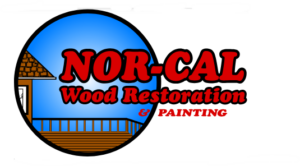Wood Staining, Preserving & Restoration
Our Wood Preserving Process
Our technicians are trained to thoroughly clean the wood surface with the necessary means before applying the preservative. Usually high pressure power washing will do; but it is some times necessary to use stain removers and acid washes to properly clean the wood. Many homes in Marin County are built on precarious hill sides. Difficult access is one of our specialty services.
1. The Cleaning Process
- If your wood has serious tannin stains, a light solution of oxalic acid and detergent will be applied to brighten wood and help in the cleaning process.
- If severe fungi, mold and mildew exist, we apply a light anti-fungal chlorine solution to kill organisms which can inhabit deep into the wood fabric.
- All openings around windows, doors, and eaves are caulked with a silicon sealer if a risk of leakage from power washing exists.
- Your wood is then carefully power washed with between 2,000 and 3,000 P.S.I. of water pressure. Power washing essentially removes the top layer of dead wood fibers much the same way sandblasters remove rust from metal. Our technicians are trained to carefully maintain an approximate 45 degree spray angle and stay with the wood grain to avoid excess fraying of the wood surface.
- The wood is allowed to dry for 48 hours, at which time the wood must be prepped for staining. The wood is then brushed and sanded to remove any fraying or splintering of the wood.
Grooming by sanding and brushing before application.
2. The Application Process
- The application goal with TWP is to saturate the wood fibers without having the product “puddle” on the surface. After an initial application is made with roller and brush, a second coat is applied approximately an hour later if the wood will accept more product. This process is referred to as, two wet on wet coats.
- If the wood is older and porous, we recommend adding 10 to 20 percent TWP series 200 with “Radcon”, to add more solids; thus increasing the protection factor. Click here to learn more about TWP and our product blending philosophy.
Natural Wood Homes
- After the wood has dried for a minimum of 48 hours, and the wood has been prepped; plastic is placed around all window, doors, light fixtures, concrete surfaces, and plant life.
- After evaluating the condition of the wood and discussing the individual desires of the client, we formulate the appropriate blend of TWP series 500 and series 200 (with Radcon). Click here to learn more about TWP and our product blending philosophy.
- Two wet on wet coats are applied with an airless sprayer.
- The plastic is then removed; and the post application cleaning process begins. The windows and any metal or painted trim are cleaned; and all debris and materials are removed from sight.
- A final walk through is done with the foreman and the client, to assure that all work has been completed to the client’s satisfaction.




